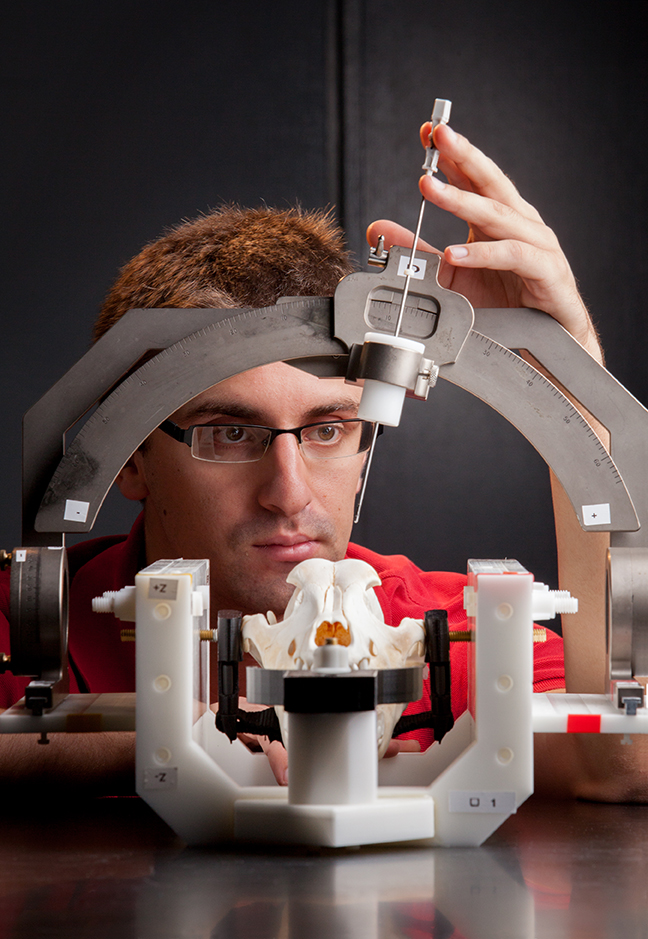UGA’s Medical Robotics Lab: Mission Possible
By: Cynthia Adams | Photos By: Nancy Evelyn
UGA’s medical robotics lab at the end of a corridor is not large, nor as technically dazzling, as you might guess. But the researchers inside wearing jeans and tennis shoes—who work practically shoulder-to-shoulder in adjoining bays—toss out Space Age concepts and terminologies like cooks tossing pancakes at an IHOP.
At least, it seems Space-Agey hearing terms and technologies concerning medical robotics and all that this conveys for us mortals. Terms such as biopsy robots. MRI-compatible, 12-lead electrocardiogram systems. Electrophysiology catheter designs for cardiovascular MRI-guided therapy. Tactile sensor arrays for tissue palpitation and MR imaging.
Wires, probes, circuitry and components are arrayed on the lab surfaces—in the hands of these young researchers true alchemy begins. And despite its high-tech purposes it feels like this is also where fun things happen.
To walk through this lab is to witness the inventive and synergistic play of the very, very bright. It is also a chance to witness “scenius,” a term coined by Brian Eno for the blending of creativity and science. “When buoyed by scenius, you act like a genius. Your like-minded peers and the entire environment inspire you,” observes technologist Kevin Kelly.

In such an environment, magnetic resonance imaging-compatible medicine is made finer and better. The UGA lab’s website describes various MRI-compatible technologies under development, including the brain biopsy model, catheters, robotic prostrate biopsy, and electrocardiogram systems.
Dr. Minta Phillips was a Harvard Medical School fellow in MRI at one of the first of three sites GE built for clinical MRI in the 1980s. She was the first author to observe that peripheral zone defect is suspicious for cancer.
“MRI is better than open surgery,” says Phillips, recently retired from Greensboro Radiology in N.C. “Medical imaging is incredibly powerful. That is why it netted the Nobel Prize in medicine. We didn’t have to do exploratory surgery anymore.”
Hearing about their relationship with her alma mater moves Phillips to comment. “This young group at Georgia is very sophisticated,” she says. “I look forward to their carrying the baton forward. The more we don’t use ionizing radiation for images, and having more diagnostic certainty with a clear picture—that is just great.”
Stan Gregory

Stan Gregory, PhD Engineering
Stan Gregory, a doctoral student in engineering, spends his morning in the University of Georgia’s College of Engineering Medical Robotics Lab whenever he isn’t teaching, and sometimes when he is. He’s especially fond of bringing students into the lab to combine both experiences. In fact, he says he gets such a charge from this that he is now thinking of becoming an academic full time.
“Stan Gregory was one of the students in the first group that I assisted this past summer,” says Clodagh Phair Miller, who began working with the engineering graduate program in February of 2013. “You really get to know the students as individuals during the application and admissions process. I think Stan is going to make a great researcher and his enthusiasm is self evident. But on top of it he is a very nice young man. I think the college and the university are lucky to have him.”
Alexander Squires

It isn’t a requirement that your grandfather, mother, or father worked on a NASA mission to join Tse’s lab. But in the case of at least two of the current graduate students working at the College of Engineering Medical Robotics Lab, it was the fuel that propelled them to land where they are. Alexander Squires and Stan Gregory both have that in their repertoire. Gregory’s mother worked on the Space Shuttle Columbia. Squire’s grandfather worked for NASA.
Squires, a master’s degree student in engineering, now attributes his path of study to his late grandfather. “He was an engineer as well, and worked on the lunar lander for the Apollo 11 mission.”
As lab manager for the College of Engineering Medical Robotics Lab, Squires says, “I was the first hire of the new lab in May 2012.” He is a native of Richmond Hill, Ga., and received a Foundation Fellowship during his senior year as a UGA undergraduate. He received the Lisa Ann Coole award, which is awarded to a fourth-year Fellow by his or her peers. He will receive his master’s degree this spring.
Like Gregory, he prefers high interaction with students and fellow researchers. For fun, he advises the Athens Academy robotics team on fabrication and design as part of his community service.
Squire’s advisor, Tse, says in praise, “Both Alex and Stan are among the top one percent students I have met in my academic career.”
He describes with pride how Squires was profiled as an “amazing student” in the College of Engineering, and how he has become involved in the larger community.
“Besides his research, Alex is a pro bono robotics teacher in Athens Academia, being involved in outreaching school students for STEM education. He is well-connected to LEGO education due to his passion in LEGO, and he has set up a good connection between our lab and LEGO education in Atlanta. Alex has the quality to become a well-rounded professor and an amazing teacher,” Tse wrote while attending a work conference. Squires volunteers as a judge for Odyssey of the Mind and the First LEGO League. The First Lego League pairs children and an adult coach with the challenge of building LEGO robots. If the effort works, it will serve to interest them in science.
Both Gregory and Squires are inaugural Dawgs within their families. Squires writes on the lab website that he became a “double Dawg” when he earned dual bachelor degrees. He also first visited UGA as a high school student while attending the state science fair.
“I toured campus and visited several labs. In my senior year, I returned to campus to interview for the Foundation Fellowship and decided that even if I didn’t receive the scholarship, UGA still felt the most like home out of all the colleges I had visited.”
In an interview for the “amazing student” article, he described his pleasure in walking from Driftmier Engineering Center to the Creamery for ice cream and breaks. He also described his penchant for getting off the beaten path, discovering new paths and trails, and studying outdoors.
But, if he could while away an afternoon with anyone, Squires wrote that it would be with “with my grandpa, who passed away while I was in high school….My dad and I have fun conversations, and I bet a three generation engineering discussion would be a riot (we’re all goofballs as well).”
Kelly describes the aspects of scenius, from mutual appreciation, rapid exchange of tools and techniques, and network effects of success. A fourth aspect of scenius, Kelly said, is a “local tolerance for novelties.” This means, he says, the creative group looks after one another, creating a buffer against conformity. Inside this “beaker” he says “strange reactions are allowed to take place.”
Inside such a place like the Medical Robotics Lab, better medicine—faster, safer—can evolve.
On the lab’s website, Squires’ project is described as a localizer box “made MRI compatible with a GE 3T MRI scanner, allowing the box to hold the subject’s head inside an MRI head coil during scanning while maintaining the same coordinate framework for subsequent needle therapy in the brain.” Officially, it is a stereotactic frame design for MRI-guided needle therapy in brain procedures.
Here again, the old enemy of imaging and proton beam radio therapy, is motion.
“Physiological motion—of arteries, or the patient moving, breathing, or stretching is the enemy. To have it fixed is extremely important. You can imagine if they are going for the brain,” says Phillips. “This idea of Squires’ is an interesting, creative idea. If you image the patient and make a custom brace, then the dog, or the child, buys their custom “box”—then whatever intervention they do is going to be precisely focused…. this is much more refined.”
The bottom line, says the retired radiologist, is the technological advances mean great precision for MRI diagnostics and surgeries.
“MRI is the youngest of the imaging modalities, and there is still much to find. The two non-ionizing imaging techniques are ultrasound and MRI. Ultrasound does not have the contrast resolution to identify tissue type.”
This, without a doubt, is a very big and valuable idea.








